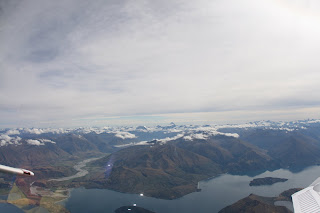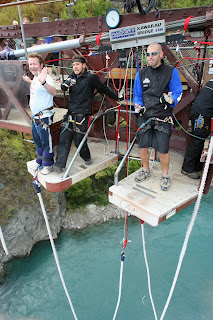Christchurch where parks and reserves account for a third of all land. By the lazy River Avon, this is a city of beautiful parks and gardens, Gothic buildings, trams, art galleries, festivals and markets.
The first Maori inhabitants of the Canterbury area were Moa-hunting tribes. The Waitaha migrated to this area in the 16th Century from the East Coast of the North Island. The area where Christchurch stands was mainly wetlands with large areas of reeds and flax. The Waitaha made fish spears out of the flax stocks and hunted and gathered food along the coast and in the estuary. The Ngati Mamoe and Ngai Tahu migrated here in more recent times.
The first european landed in the Canterbury area in 1815, some 45 years after Captain Cook had sighted "Banks Island" (later found to be a peninsula). The whalers, seal hunters and flax traders however never settled and so it was 1840 before the first europeans were to settle on the Canterbury Plains. The French were the first to settle the Akaroa region which remains steeped in French influence.
By 1850 whaling ships were operating out of Lyttelton Harbour and the first organised settlement began with the founders of Christchurch arriving on the first four ships. The model Anglican colonial settlement was originally to have been sited at the head of Lyttelton Harbour but there was not enough space here for a large urban centre.
I begin my morning with breakfast at The Daily Grind on City Mall before I head across Friendship Corner, where a peace pole stands, to St Michael's and All Angels, the Parish Church of Christchurch.
Friendship Corner is a lovely spot where trees characteristic of the countries where Christchurch has sister cities stand. There is the Tokyo Cherry for the city of Kurashiki, Japan; the Tasmanian Blackwood for the city of Adelaide, South Australia; the English Oak for Christchurch in Dorset; the Maidenhair tree for Gansu Province, China and the Red Ash for the city of Seattle, Washington.
St Michael's and All Angels was the city's first Anglican church opening on July 20th 1851 some seven months after the arrival of the first settlers. It was the first church built by european settlers on the Canterbury Plains.
The original building was a makeshift schoolroom-cum-church so small that people frequently hit their heads on the beams. The early history of this church is closely connected with that of the young settlement reflecting the difficulties of colonial life. Yet by the late nineteenth century St Michael's and All Angels was the leading Anglican parish in the diocese and possibly even New Zealand.
The present church is the third on this site and was designed by W.F. Crisp being consecrated in 1872. Originally the pro-Cathedral it is considered to be one of the finest wooden churches in the world and I would agree with that...it was stunning!!
St Michael's and All Angels is one of the largest timber Gothic churches in the world and it has an impressive collection of stained glass that is amongst the best I have ever seen anywhere.
Windows such as the Good Shepherd (manufactured in 1886 by Lavers and Barraud in London) are stunning, and I cannot say that I have a favourite; but if I had to choose the South Transept Window with God the Holy Spirit in the rose window surrounded by six of the nine fruits of the Holy Spirit caught my eye.
To the side of the church stands a belfry that was built in 1861 and designed by Canterbury's leading Victorian architect B.W. Mountfort. The 687 kg bell it houses was brought out from England on the first four ships and was the settlements first timepiece being rung every hour of daylight.
In its early days St Michael's and All Angels was a fashionable carriage church being favoured by the inhabitants of the city's grander houses. However the institution of Father Harry Darwin in 1910 gave the church notoriety as a high church. Today St Michael's and All Angels remains the centre of Catholic spirituality within the Anglican Church of Aotearoa, New Zealand and Polynesia. St Michael's and All Angels remains a case study of the development of Anglicanism in New Zealand and the changing role of churches in their communities.
This church is a wonderful example of a colonial Victorian church but it is also so much more...it is a beautiful place of worship.
This was the place of worship for the Canterbury pilgrims and they built themselves a fine church. I particularly enjoyed the Pilgrim's Chapel which had been used as a vestry until 1901 when it was dedicated (Sunday September 29th, the Festival of St Michael and All Angels) to celebrate the jubilee of the parish (July 1851-July 1901) and to commemorate the arrival of the pilgrim's some fifty years before.
A Prayer for Aotearoa, New Zealand.
God of the southern seas
and of these islands
of Maori, Pakeha and of all who dwell in our land
we give you thanks and praise for our country
and for what we have achieved together.
Increase our trust in one another:
strengthen our quest for justice
and bring us to unity and a common purpose.
You have made us of one blood:
make us also of one mind.
I enjoy in my travels seeing things that your average tourist never seeks out and that many locals are unaware of.
My next stop is to be the Gallipoli Oak that was planted in memory of the New Zealanders who fought against the Turks on the Gallipoli Peninsula in World War I. This military action is remembered each year on ANZAC Day; April 25th. This particular oak tree standing alongside the Avon was grown from one of four acorns collected at Gallipoli by Captain Douglas Deans in 1919.
Close by the oak stands a new addition to the city. The statue of 24213 Sergeant Henry James Nicholas VC MM of the 1st Battalion Canterbury Regiment. He was awarded the Victoria Cross after leading an assault on a German stronghold at Polderhoek, Belgium on December 3rd 1917 and in 1918 he was awarded the Military Medal for gallantry in the field in a separate action. Sadly, he was killed in action just 19 days before the Armistice on a bridge at Beaudignies Village, France.
This statue was unveiled on the 7th of March this year and at its foot lies a somewhat withered wreath with a poignant family message which serves to remind us of the humanity of the loss.
The Canterbury Association set aside a 400 acre reserve when planning the settlement. This became Hagley Park and the Botanical Gardens. The plan for the gardens was carried out by J.F. Armstrong the first curator (1867-1879). The reserve was placed between the town and Riccarton at the request of the Deans Brothers who had been farming at Riccarton in the 1840's before the settlers arrived. They did not want the town too close to their farm.
Today I learnt that there are actually 740 parks covering a total area of 3,000 hectares in the Christchurch area, 13 of them major metropolitan parks. Hagley Park is the largest at 405 acres and it is home to the Botanic Gardens.
The gardens are 75 acres that until 1863 were largely natural wetlands and sand dunes.
The Botanic Gardens were founded on July 9th 1863 when an English Oak was planted in the gardens to commemorate the marriage of Queen Victoria's eldest son Prince Albert Edward to Princess Alexandra of Denmark, the daughter of Christian IX, King of Denmark.
The tree was grown from one of the four acorns sent in 1861 to Rev Richard Taylor in Wanganui, by Queen Victoria to commemorate the death of her husband. Life continues to spring from that oak with a new oak planted on July 9th 2003 to celebrate the 140th anniversary of the Botanic Gardens. This new oak was a graft taken from the Albert Edward Oak and it was planted by descendants of the first government gardener Enoch Barker who had planted the original in 1863.
Throughout the gardens there are many trees planted by the great and the good such as the Acer Purple Norway Maple that was planted by the Town Clerk to commemorate the coronation of HM The Queen on June 4th 1953. Royal commemoration is a common theme with the Chairman of the Domains Board planting a tree on June 6th 1893 to commemorate the marriage of the future King George V.
The Botanic Gardens were stunning from the scent from the rose garden to the Peacock Fountain (a fine example of Edwardian design cast in iron and made by the Coalbrookdale Foundry in Shropshire). The three tiers with dolphins, herons, lily leaves and foliage provided a wonderful welcome to these exquisite grounds. Even Futuro, the UFO house designed by Finish architect Matti Suuronen in 1968 didn't look too out of place.
During my time in the gardens I had lunch at the Curator's House restaurant.
Tonight I rejoin my mates from my North Island tour and although I am strictly no longer on their tour I am rejoining my old room-mate for one last time.
Thank God Christchurch is flat as I go trundling through the streets loaded like a pack horse. After checking into the Copthorne Hotel on Victoria Square we head out for our final tour dinner at Vic and Whale.
The really go for St Paddy's Day here in New Zealand and today, March 16th, is officially known as St Practice Day and we head off to The Bog for a night of song and dance and practice for tomorrow...at the close of the day it is time for a rickshaw ride around the city with Paul, Wendy, Laura, Bill and Blon.
It was great to see my old mates again and the after party went on in Paul and I's room until just after 3am.
Tonight Paul and I wind up with only a double bed in our room...it is becoming a habit me sleeping with my room-mates...after three nights in a double bed with Rob in Darwin...now its Paul.
































